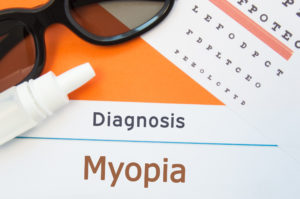July 1, 2020
By Debbie Jones, BSc, FCOptom, FAAO
 Almost without exception, a paper or article written about myopia starts with the alarming statistics and predictions regarding the prevalence of myopia worldwide. Globally, clinicians and researchers are hopefully well aware by now of the projection that by 2050, 50 percent of the world’s population will be myopic.1 While this traditionally sets the scene for the need for action to combat this epidemic, what exactly does the term myopia management mean, and how can it be put into practice?
Almost without exception, a paper or article written about myopia starts with the alarming statistics and predictions regarding the prevalence of myopia worldwide. Globally, clinicians and researchers are hopefully well aware by now of the projection that by 2050, 50 percent of the world’s population will be myopic.1 While this traditionally sets the scene for the need for action to combat this epidemic, what exactly does the term myopia management mean, and how can it be put into practice?
The term myopia management has been used synonymously with myopia control, and both terms are used almost interchangeably. To help define myopia management, it is useful to use the definition of myopia as a guide. Myopia occurs when there is a mismatch between the axial length and refractive components of the eye, such that images focus in front of the retina. Myopia progression occurs because of continued increase in axial length. In terms of refractive error, myopia is defined as a spherical equivalent refractive error of greater than or equal to -0.50D.1 Myopia management can be defined as the slowing down of axial elongation, which, by definition, also slows down the rate at which the dioptric value of the refractive error increases.
The onset of myopia typically occurs somewhere between the ages of 6 and 12 years.2,3 In the past few decades, onset has shifted towards the younger end of the age range, and, with this shift, refractive errors have increased in magnitude.4,5 High myopia has recently been defined as a spherical equivalent refractive error greater than or equal to -6.00D.6
Identify Risk Factors
There is general agreement in the literature regarding the factors that impact the development of myopia. Myopia prevalence increases with age, is associated with less time spent outside, is more prevalent in certain ethnic populations, and has a strong genetic association.4,7-11 The association with increased near work is still somewhat controversial, with some studies finding an association between myopia and the type of near work and others an association with the duration of continuous near work rather than an accumulative duration of near work.12,13
The term pre-myopia has been used to identify those patients who are at risk of developing myopia. The CLEERE study identified refractive error at certain ages to be the most significant predictor of future myopia.14 The specific predictive thresholds are shown in Table 1.
Table 1 – Refractive Threshold for Prediction of Future Myopia14
| AGE (yrs.) | Refractive threshold for risk of developing myopia |
| 6 | <+0.75D |
| 7-8 | ≤+0.50D |
| 9-10 | ≤+0.25D |
| 11 | ≤0D |
Identifying patients who are at risk of developing myopia, and in particular high myopia, is an essential first step that can help guide practitioners towards considering myopia management for a patient, which in turn can prompt initial discussions with the patient and their parents. The age of onset of myopia appears to be a good predictor of the risk of high myopia, with an earlier age of onset being a significant risk factor.15,16
Patients with high myopia are at significantly greater risk of developing eye diseases that can have a severe impact on visual acuity, including glaucoma, cataract, retinal detachment, and myopic maculopathy.17,18 It is the axial length of the eye that is the key risk for myopia-related ocular pathology. Data from Europe17 concluded that an axial length of 26mm to less than 28mm increased the likelihood of vision impairment by age 75 to 25 percent, compared to a likelihood of only 3.8 percent in individuals with an axial length less than 26mm. The incidence of visual impairment increases to 90 percent in seniors with an axial length of 30mm or greater. Fricke et al.19 predict that without intervention, the number of people with visual impairment due to myopic maculopathy will increase from an estimated 10 million people in 2015 to 55.7 million in 2050 (see Table 2).
Table 2- Global Visual Impairment and Blindness Due to Myopic Maculopathy19
| Visual Impairment | Blindness | |
| 2015 | 10.0 million | 3.3 million |
| 2050 | 55.7 million | 18.5 million |
Flitcroft has very clearly articulated that there is no such thing as a “safe” level of myopia, and even low levels of myopia increase the odds of ocular disease compared to emmetropia.18 More recently, Bullimore and Brennan20 concluded that each additional one diopter of myopia increases the prevalence of myopic maculopathy by 67 percent. Their review of the data from 21,000 patients also led to the conclusion that slowing down the progression of myopia by just one diopter should reduce the likelihood of a patient developing myopic maculopathy by 40 percent.
What Is Myopia Management?
Myopia management refers to the decision to implement a strategy to slow down the progression of myopia in a child. It is a decision that is based on substantial scientific evidence that myopia progression can be slowed and that it is the most appropriate clinical management for the patient in question. The initial stage of myopia management is a discussion with the patient and the parents. It needs to occur as soon as there is evidence of myopia, or ideally in the pre-myopia stage.
Provide Information
The initial benefits of myopia management may be relatively invisible to the patient and their family. The child may still see reasonably well at distance with minimal spectacle correction, or with no correction at all, and the benefits for reduction of potential future risk of associated ocular pathology are difficult concepts to grasp. One of the critical challenges is to be able to convey understanding to the patient and their parents that myopia management is not a short-term treatment, but rather a long-term commitment over several years. Parents, however, can more easily understand things that may benefit their child in the short term. What is well understood by clinicians and parents alike are the advantages of lower prescriptions,20 including:
- better uncorrected acuity
- potentially better corrected acuity
- better future refractive surgery outcomes (including better post-op visual quality)
These advantages provide excellent discussion points when introducing the concept of myopia management to parents. Practitioners should use simple language when explaining myopia, in particular the risks of high myopia, and should avoid overwhelming parents with an excessive amount of information. Families may need time to consider the information provided and the supporting material that they can take with them should be available, which reiterates what has been discussed. Links to appropriate electronic information can also be provided. Patients and parents must have an opportunity to ask questions and to discuss the options available, which may take place at a subsequent visit. Staff training is imperative such that questions can also be answered by other personnel in the practice if necessary.
What Is the Goal of Myopia Management?
The overarching goal of myopia management is to slow the progression of axial length to reduce the risk of long-term complications associated with myopia. There is no magic number, but the general consensus among practitioners is that a 50 percent reduction in the rate of progression is clinically significant. Considering a typical patient presenting at age eight with a myopic refraction of -1.00D and predicted to progress by, on average, -0.50D per year, Table 3 demonstrates the predicted refractive error at age 16 with various levels of myopia management efficacy.
Table 3: Effect of Various Myopia Management Effects
| Myopia management efficacy % | Final refractive error |
| 0 | -5.00D |
| 25 | -4.00D |
| 50 | -3.00D |
| 75 | -2.00D |
| 100 | -1.00D |
As already discussed, any reduction is better than none, and even a relatively small impact on progression can affect the long-term ocular health of a patient.
Which Management Option Is the Right One to Choose?
There are no rules or specific guidelines about which myopia management option is the right one to choose for a particular patient. The choice should be made jointly with the parents and the patient, considering many factors. It is outside the realm of this article to discuss all the options and the evidence to support them. However, broadly there are three main options to choose from: pharmaceuticals (atropine), contact lenses (soft multifocal/dual focus contact lenses and orthokeratology), and spectacles. When reviewing the literature and looking for evidence to support a myopia management strategy, the correlation between effect on axial elongation and refractive error must be taken into consideration. The treatment effect for each modality varies dependent on the studies reported. However, in general terms, most of the options available have evidence to demonstrate a slowing of the rate of myopia progression by 30 percent to 80 percent.21,22
Close monitoring of patients is essential to ensure that the strategy employed is having the desired effect and that this effect is maintained over time.
What Myopia Management Is Not
Refractive correction, with conventional single vision, spherical devices (spectacles or contact lenses) to achieve good visual acuity is not myopia management. There is no evidence that simple spherical designs of contact lenses or spectacles can slow down the rate of axial length elongation.
It is not uncommon for parents to request that a prescription be reduced such that the full refractive error is not prescribed. This is based on an unsupported assumption that this will lead to less progression. Practitioners should avoid being pressured into this strategy and, in fact, can point to reasonable evidence that undercorrection of myopia should not be adopted and may, in fact, lead to an increase in the rate of myopia progression.23-25
A wait-and-see approach also has no scientific foundation. It has been reported that myopic children show significant axial elongation up to three years before, and for the five years following, the onset of myopia.26 Waiting for your patient to become more myopic is not evidence-based myopia management.
In Conclusion
Eye care practitioners should:
- Be proactive
- Identify risk factors for myopia and high myopia
- Provide information, advice, and recommendations to children and their parents
- Prescribe appropriate interventions to slow myopia progression and reduce the risk of developing high myopia
These four recommendations provide a useful framework for myopia management in practice. Given that the burden of blindness and visual impairment will continue to rise without intervention, it is extremely important to be proactive. Myopia management should be viewed as the standard of care that is expected of all eye care practitioners.

Debbie Jones, BSc, FCOptom, FAAO, is a clinical professor at the School of Optometry and Vision Science and a clinical scientist at the Centre for Ocular Research & Education (CORE) at the University of Waterloo. Her main area of clinical focus is in pediatric optometry, and her primary area of research activity is in the field of myopia control.
References
- Holden BA, Fricke TR, Wilson DA, Jong M, Naidoo KS, Sankaridurg P, et al. Global Prevalence of Myopia and High Myopia and Temporal Trends from 2000 through 2050. Ophthalmology. 2016;123(5):1036-42.
- Kleinstein RN, Sinnott LT, Jones-Jordan LA, Sims J, Zadnik K, Collaborative Longitudinal Evaluation of E, et al. New cases of myopia in children. Arch Ophthalmol. 2012;130(10):1274-9.
- Edwards MH. The development of myopia in Hong Kong children between the ages of 7 and 12 years: a five-year longitudinal study. Ophthalmic Physiol Opt. 1999;19(4):286-94.
- Lin LL, Shih YF, Hsiao CK, Chen CJ. Prevalence of myopia in Taiwanese schoolchildren: 1983 to 2000. Ann Acad Med Singapore. 2004;33(1):27-33.
- Fan DS, Lai C, Lau HH, Cheung EY, Lam DS. Change in vision disorders among Hong Kong preschoolers in 10 years. Clin Exp Ophthalmol. 2011;39(5):398-403.
- Flitcroft DI, He M, Jonas JB, Jong M, Naidoo K, Ohno-Matsui K, et al. IMI – Defining and Classifying Myopia: A Proposed Set of Standards for Clinical and Epidemiologic Studies. Invest Ophthalmol Vis Sci. 2019;60(3):M20-M30.
- Rose KA, Morgan IG, Ip J, Kifley A, Huynh S, Smith W, et al. Outdoor activity reduces the prevalence of myopia in children. Ophthalmology. 2008;115(8):1279-85.
- Dirani M, Tong L, Gazzard G, Zhang X, Chia A, Young TL, et al. Outdoor activity and myopia in Singapore teenage children. Br J Ophthalmol. 2009;93(8):997-1000.
- Jones LA, Sinnott LT, Mutti DO, Mitchell GL, Moeschberger ML, Zadnik K. Parental history of myopia, sports and outdoor activities, and future myopia. Invest Ophthalmol Vis Sci. 2007;48(8):3524-32.
- Ip JM, Huynh SC, Robaei D, Kifley A, Rose KA, Morgan IG, et al. Ethnic differences in refraction and ocular biometry in a population-based sample of 11-15-year-old Australian children. Eye (Lond). 2008;22(5):649-56.
- Rudnicka AR, Owen CG, Nightingale CM, Cook DG, Whincup PH. Ethnic differences in the prevalence of myopia and ocular biometry in 10- and 11-year-old children: the Child Heart and Health Study in England (CHASE). Invest Ophthalmol Vis Sci. 2010;51(12):6270-6.
- Huang PC, Hsiao YC, Tsai CY, Tsai DC, Chen CW, Hsu CC, et al. Protective behaviours of near work and time outdoors in myopia prevalence and progression in myopic children: a 2-year prospective population study. Br J Ophthalmol. 2019.
- Ip JM, Saw SM, Rose KA, Morgan IG, Kifley A, Wang JJ, et al. Role of near work in myopia: findings in a sample of Australian school children. Invest Ophthalmol Vis Sci. 2008;49(7):2903-10.
- Zadnik K, Sinnott LT, Cotter SA, Jones-Jordan LA, Kleinstein RN, Manny RE, et al. Prediction of Juvenile-Onset Myopia. JAMA Ophthalmol. 2015;133(6):683-9.
- Chua SY, Sabanayagam C, Cheung YB, Chia A, Valenzuela RK, Tan D, et al. Age of onset of myopia predicts risk of high myopia in later childhood in myopic Singapore children. Ophthalmic Physiol Opt. 2016;36(4):388-94.
- Iribarren R, Cortinez MF, Chiappe JP. Age of first distance prescription and final myopic refractive error. Ophthalmic Epidemiol. 2009;16(2):84-9.
- Tideman JW, Snabel MC, Tedja MS, van Rijn GA, Wong KT, Kuijpers RW, et al. Association of Axial Length With Risk of Uncorrectable Visual Impairment for Europeans With Myopia. JAMA Ophthalmol. 2016;134(12):1355-63.
- Flitcroft DI. The complex interactions of retinal, optical and environmental factors in myopia aetiology. Prog Retin Eye Res. 2012;31(6):622-60.
- Fricke TR, Jong M, Naidoo KS, Sankaridurg P, Naduvilath TJ, Ho SM, et al. Global prevalence of visual impairment associated with myopic macular degeneration and temporal trends from 2000 through 2050: systematic review, meta-analysis and modelling. Br J Ophthalmol. 2018;102(7):855-62.
- Bullimore MA, Brennan NA. Myopia Control: Why Each Diopter Matters. Optom Vis Sci. 2019;96(6):463-5.
- Walline JJ. Myopia Control in 2019. Contact lens spectrum. 2019;34(March 2019):18-25.
- Bullimore MA, Richdale K. Myopia Control 2020: Where are we and where are we heading? Ophthalmic Physiol Opt. 2020;40(3):254-70.
- Logan NS, Wolffsohn JS. Role of un-correction, under-correction and over-correction of myopia as a strategy for slowing myopic progression. Clin Exp Optom. 2020;103(2):133-7.
- Adler D, Millodot M. The possible effect of undercorrection on myopic progression in children. Clin Exp Optom. 2006;89(5):315-21.
- Chung K, Mohidin N, O’Leary DJ. Undercorrection of myopia enhances rather than inhibits myopia progression. Vision Res. 2002;42(22):2555-9.
- Mutti DO, Hayes JR, Mitchell GL, Jones LA, Moeschberger ML, Cotter SA, et al. Refractive error, axial length, and relative peripheral refractive error before and after the onset of myopia. Invest Ophthalmol Vis Sci. 2007;48(6):2510-9.













